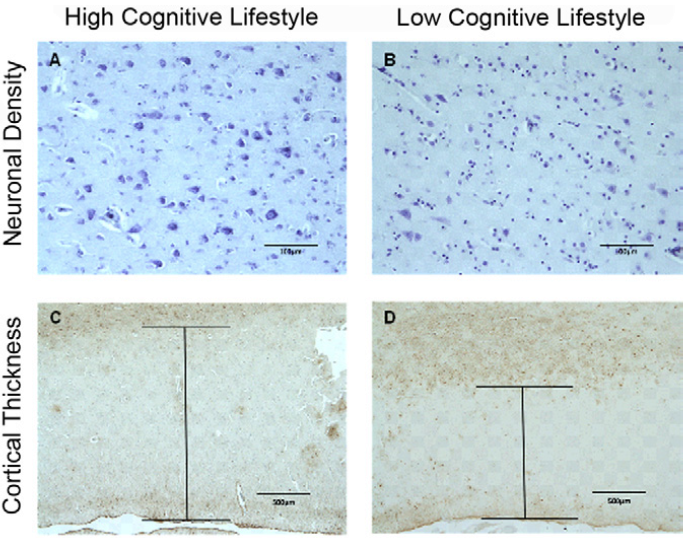Protecting your brain: ‘use it or lose it’
April 25, 2012

Effects on neurons of an active cognitive lifestyle in Brodmann area 9 (mid-prefrontal lobe, involved in memory). A high cognitive lifestyle score was associated with increased neuronal density (A, B) and greater neocortical thickness (C, D). (Credit: M. J. Valenzuela et al./Biol Psychiatry)
Cultivation of an active cognitive lifestyle through lifespan engagement in a rich array of mentally stimulating activities may help reduce dementia risk, according to a major study of more than 13,000 individuals aged over 65 years and followed for 14 years.
An active cognitive lifestyle score (CLS) in men was associated with less cerebrovascular disease, and in women was associated with greater brain weight. In both men and women, a high score was associated with greater neuronal density and cortical thickness in the frontal lobe.
“Overall, our research suggests that multiple complex brain changes may be responsible for the ‘use it or lose it’ effect,” said Associate Professor Michael J. Valenzuela, a brain aging expert at the Brain and Mind Research Institute, University of Sydney, Australia, who led this new study. “This research throws some light on what may be happening at the biological level.”
Study methodology and results
Researchers in multiple institutions in the U.K. and Australia used data from the Cognitive Function and Ageing Study (CFAS), a large population-based study in the United Kingdom that has been following more than 13,000 elderly individuals prospectively since 1991.
The CLS is based on detailed information about an individual’s range of educational, occupational, and social activities and has been shown to independently predict incident dementia in the larger CFAS sample. It includes years of education, occupational complexity coded according to social class and socioeconomic grouping, and social engagement based on frequency of contact with relatives, neighbors, and social events.
At the time of this study, 329 brains had been donated and were available for analysis. Brains were compared based on the individual’s dementia status at death (yes or no) and CLS (low, middle, or high).
The three CLS groups did not differ among multiple Alzheimer’s disease (AD) neuropathology measures, including plaques, neurofibrillary tangles, and atrophy. This means that cognitive lifestyle seems to have no effect on the brain changes typically seen in those with Alzheimer’s disease.
“These findings suggest that increased engagement in stimulating activities are part of a lifestyle that is, overall, more healthy,” commented Dr. John Krystal, Editor of Biological Psychiatry. “Rather than specifically protecting the health of activated circuits, it seems that a more active lifestyle has general effects on brain health reflected in greater neuronal density and preservation of the blood supply to the brain.”
With a globally aging society (affected individuals rise to over 100 million by 2050) and the risk of dementia increasing significantly with age, dementia-prevention strategies are of rising importance, according to the study authors.
Ref.: Michael J. Valenzuela rt al., Multiple Biological Pathways Link Cognitive Lifestyle to Protection from Dementia, Biological Psychiatry, 2012 [DOI: 10.1016/j.biopsych.2011.07.036]